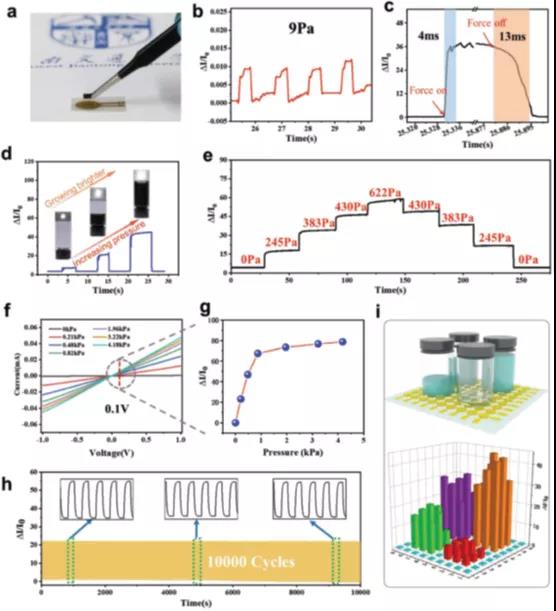MXene Flexible Piezoresistive Micro Force Sensor
QQ Academic Group: 1092348845
Detailed
¡¾Research Background¡¿
Microelectronic devices play an important role in human health monitoring, intelligent robots, and human-machine interfaces. In this field, an important challenge now widely recognized is how to make these devices more versatile under the trend of integration and miniaturization. To overcome this challenge, combining functionally independent sensors into a composite structure to form a multifunctional sensor array is an effective strategy. However, it becomes more and more difficult to integrate multiple independent devices with different functions into a device with increasingly limited space, resulting in complex operations and expensive operations, which conflict with the requirements for miniaturization and integration of microelectronic devices. As an option, multi-functional sensing can be implemented on one device through a precise and compact design. In general, force detection, as the basic way for objects to interact with other objects, can help us achieve multifunctional information sensing such as pulse detection, speech recognition, and load weight. So far, various mechanisms have been used for force sensing, such as piezoresistive, piezoelectric, triboelectric, etc. Among them, the flexible piezoresistive pressure sensor has attracted much attention because of its simple structure, feasible manufacturing process, low energy consumption, easy signal processing, and high sensitivity. In recent years, flexible piezoresistive pressure sensors have developed rapidly, mainly focusing on structural design and optimization of piezoresistive materials. As a new two-dimensional material, MXenes is a new type of laminated material that can be used as a piezoresistive material. Its compressible layered laminated structure is a key factor to change the internal resistance and conductivity of MXene. However, the current MXene-based pressure sensor quickly reaches the deformation limit of MXenes in the limited space of the 2D plane under external stimulation, which greatly limits the performance of the sensor. In addition, most previous studies focused only on the sensitivity or limit of pressure detection or other indicators, and few people could perceive multifunctional micro-forces in a simple structure (such as sound, touch, and motion recognition).
[Achievement Profile]
Recently, Dr. Deng Weili, Professor Fang Yong and Yang Weiqing from Southwest Jiaotong University published a research paper titled: Microchannel-Confined MXene Based Flexible Piezoresistive Multifunctional Micro-Force Sensor in an internationally renowned academic journal Advanced Functional Materials . This article shows a New MXene flexible multifunctional piezoresistive pressure sensor based on microchannel constraints. Due to the micro-channel confinement effect of the fingerprint structure channel, MXenes can be constrained in the groove well to form a three-dimensional superimposed structure, which makes MXenes have a larger deformation space and more sensitive micro-movement ability. In combination with the fingerprint-microstructure channel and accordion-microstructure microbody, as the external force changes, the distance between the different microbody in the microbody and the adjacent interlayer will be reduced to different degrees, resulting in corresponding resistance. A similar change will occur. Utilizing this elastic constraint effect, the developed piezoresistive pressure sensor has a low detection limit of 9 Pa, high sensitivity of 99.5 kPa -1 , fast response time of 4 ms, and high repeatability of more than 10,000 times. More importantly, the pressure sensor can realize multi-function micro force sensing of pressure, sound, acceleration and even micro-motion, which makes it possible to make a flexible piezoresistive multi-function micro force sensor in a low cost and simple way.
[Picture and text guide]

Figure 1. Schematic diagram of a pressure sensor.

Figure 2. Working mechanism of MXenes piezoresistive pressure sensor based on microchannel constraints and basic performance of the sensor

Figure 3. Electrical performance of a pressure sensor with a channel depth of 78 ¦Ìm.

Figure 4. Application of pressure sensors in micro signal detection.
[Summary of this article]
This paper uses the designed channel confinement effect and compressible laminated MXene (Ti 3 C 2 T x ) to develop a highly sensitive flexible multifunctional piezoresistive pressure sensor based on microchannel confinement. This design sensor not only achieves low detection limit (<9 Pa), high sensitivity (99.5 kPa -1 ) and fast response (4 ms), but also can realize multifunctional micro-force sensing at the same time, such as detecting wrist pulse, sound , Fretting, etc. This multi-functional sensing feature makes the sensor a promising application in small flexible electronic devices, which can be used in wearable medical monitoring equipment, smart robots, and efficient human-machine interfaces.
Literature link:
https://dx.doi.org/10.1002/adfm.201909603.
Source:
- Previous£º Unique manganese ion i
- Next£º MXene breakthrough: Na


 mxene academic
mxene academic
